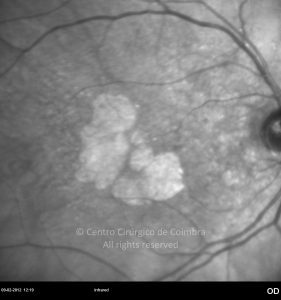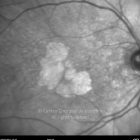O sarampo é causado por um paramyxovírus que é altamente contagioso e é tipicamente contraído na infância. As complicações mais graves incluem opacificação da córnea e amaurose, encefalite, diarreia grave e com consequente desidratação, infeções do ouvido e pneumonia.
As manifestações oculares mais comuns da infeção do sarampo adquirido são a queratite autolimitada ou conjuntivite, nas fases iniciais da infeção, embora também possa ocorrer uma retinopatia. Durante as fases agudas do envolvimento da retina, o fundo pode apresentar vasos atenuados, edema do disco ótico, pequenas hemorragias e lesões estelares maculares. Os achados da retina incluem edema macular, anomalias no epitélio pigmentar, coroidite, infiltrados retinianos esbranquiçados, descolamentos serosos maculares, áreas de despigmentação da retina e nevrite ótica.
As infeções congénitas também podem ocorrer e as suas manifestações oculares incluem catarata e retinopatia pigmentar.
Diagnóstico Diferencial:
- Coriorretinopatia serosa central
- Retinopatia pigmentar
- Retinicoroidite toxoplásmica
- Doença de Vogt-Koyanagi-Harada









